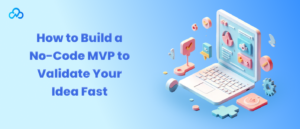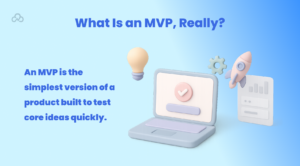How to Build a No-Code MVP to Validate Your Idea Fast

Let’s be honest, most startup ideas begin in chaos. Scribbled notes. Random thoughts in your phone at 2 a.m. And then this question creeps in: “Should I build this?” But here’s the trap, too many people jump straight into full-on development. Code, infrastructure, funding, features. Before they’ve even tested if the idea’s worth anything. That’s why defining an MVP in software is so crucial. You need to know if your idea solves a problem before investing serious time and money. And thanks to no-code tools, you don’t need a team of engineers to get there. You just need to build something small, functional, and testable, fast.
This guide is for anyone who wants to validate their idea with as little fluff (and budget) as possible. We’ll look at how to define and build a no-code MVP, go over some minimum viable product examples that actually worked, and unpack what a real MVP development cost might look like today. Whether you’re flying solo or considering an MVP software development agency, we’ve got ground to cover.
What Is an MVP, Really?

Some people overthink this part. Others barely define it. So here’s a no-BS definition: an MVP in software is the smallest, fastest version of your product that helps you learn something useful.
That’s it.
Forget the whitepapers. An MVP in software isn’t about shipping half of everything, it’s about shipping 100% of the core. You don’t need sign-up flows, dashboards, payment processing, and AI suggestions if none of that proves your main assumption.
Let’s say you’re building a service to match freelancers with clients. You could spend three months building an app. Or, you could make a Typeform and manually connect people. If it works? Great, you just validated the idea without touching a line of code.
When you’re defining an MVP, the goal isn’t to launch, it’s to learn. Learn if people care, if they’ll use it. Learn what breaks, what doesn’t matter.
And yeah, sometimes it looks ugly. Sometimes it’s held together with Zapier, duct tape, and blind optimism. But if it helps you move forward, it’s doing its job.
Why No-Code MVPs Make Sense
Not long ago, if you had an idea but didn’t know how to code, you were stuck. You either shelled out for a dev team, learned to build it yourself, or gave up. That’s changed, dramatically.
No-code tools like Webflow, Glide, Bubble, and Softr let you put together real, working products in a fraction of the time it used to take. Even backends, thanks to Airtable or Notion, can be built with clicks, not keystrokes.
And this isn’t just about convenience. It’s about speed, control, and keeping your MVP development cost low enough that you’re not afraid to mess up. You don’t need a polished app. You need a rough draft that speaks loud enough to get feedback.
Let’s say you’re defining an MVP for a mobile budgeting tool. You could either build the full iOS app, or use Glide and Google Sheets to simulate the experience. You’ll get real user input without burning $10,000 and three months of dev time.
It’s also why many founders now team up with an MVP software development agency that specializes in no-code. These agencies skip the fluff and help you ship fast, not by cutting corners, but by focusing only on what actually needs to exist to validate your idea.
No-code doesn’t mean no value. It just means you’re moving faster, with less risk.
Real-World Examples of Minimum Viable Products
You’ve probably heard the term “MVP” thrown around in every startup circle. But what does it really look like in practice?
Here are a few minimum viable product examples that prove just how scrappy, and effective, an MVP in software can be:
-
Dropbox launched with a video. That’s it. No product. Just a screencast of how it would work. The feedback? Wild demand. It was enough to raise money and build the real thing.
-
Zappos didn’t start with inventory or a warehouse. The founder walked into local shoe stores, took pictures, and posted them online. When someone placed an order, he went back, bought the shoes, and shipped them himself.
-
One early-stage founder created a tutoring marketplace using Airtable, Webflow, and Calendly. No code. No backend. Just a working funnel. In three weeks, she had paying customers, and proof her idea was viable.
What do all of these MVPs have in common? They weren’t “products” in the traditional sense. They were fast, stripped-down experiments that solved a clear problem.
Defining an MVP doesn’t mean lowering your standards, it means getting honest about what matters most. Whether you build it alone or hire a no-code-savvy MVP software development agency, the mission stays the same: build less, learn more.
How to Build a No-Code MVP (The Messy, Honest Way)

So, you’re ready to build. You’ve got the idea. Maybe even a few users lined up. But how do you actually create something useful without sinking weeks, or your sanity, into it?
Start with this: defining an MVP isn’t about building fast. It’s about deciding what not to build. You’re trying to isolate the bare minimum that still solves the problem.
Here’s how that process looks when it’s messy and real:
-
Write down what your product does. Not what it could do, what it must do. What’s the promise to your user?
-
Delete 80% of it. Brutal, but necessary. This is your core.
-
Choose your no-code tools. Glide if you want a quick mobile app. Webflow for polished landing pages. Bubble if you need logic. Airtable or Notion for managing content or data.
-
Stitch things together. Use Zapier, Make, or native integrations. You’re creating workflows, not software masterpieces.
-
Launch to 5–10 real users. That’s enough. Post in a Slack group. DM some friends. The goal is not to go viral, it’s to observe.
-
Collect feedback like gold. What confused people? What did they love? Where did they drop off? Every click tells you something.
The beauty of no-code MVPs is that you don’t have to build alone. Plenty of startups bring in an MVP software development agency for this exact phase. Not to build the final product, but to help you test assumptions fast, without getting stuck in decision loops.
Remember: you’re not building the product. You’re building the first thing that teaches you something real. That’s what MVPs in software are all about.
The Hidden Costs and Where Agencies Fit In
Now for the part nobody likes talking about: cost.
Yes, no-code tools save time. Yes, they cut down on development. But your MVP development cost isn’t just money, it’s energy, focus, and opportunity cost.
Let’s break it down a bit:
|
MVP Build Type |
Ballpark Cost |
What You’re Paying For |
|
DIY with no-code tools |
$0–$1,000 |
Your time, tool subscriptions, and a learning curve |
|
Freelance help |
$2,000–$7,000 |
Implementation, UI tweaks, maybe automation support |
|
MVP dev agency |
$8,000–$30,000+ |
Strategy, UX, testing, user feedback loops, polish |
You could absolutely build something valuable on your own. But there’s also value in speed and clarity. Hiring an MVP software development agency isn’t just about outsourcing, it’s about gaining perspective. These agencies know what to cut, what to launch, and what will waste your time.
Of course, agencies come with a price tag. But if you’re juggling multiple responsibilities, or just want sharper feedback faster, it might be the best money you spend.
The real trap? Spending six months building something beautiful that nobody wants. That’s the most expensive MVP of all.
Technical FAQs
What does defining an MVP actually mean?
It means figuring out the smallest, simplest version of your idea that still helps users solve a problem. You’re not aiming for complete, you’re aiming for clear. The goal is to test assumptions, not launch a full product.
How much does a no-code MVP really cost?
If you’re building it yourself, your MVP development cost could be under $500. Add in a freelancer, and maybe you’re at $3k–$7k. Work with an MVP software development agency, and you’re likely looking at $10k–$30k depending on scope. Still cheaper than building the wrong thing.
Can you scale a product built with no-code tools?
Yes, to a point. Many founders build their MVP in no-code, validate the idea, and then either scale with more advanced tools or rebuild with a dev team. For early traction and learning, no-code is perfect.
Should I work with an MVP software development agency?
If you’re short on time, unsure where to start, or want professional guidance, yes. A good agency doesn’t just build, they help with defining an MVP, scoping features, setting timelines, and getting to feedback faster.
What are some common mistakes with MVPs in software?
Trying to do too much. Polishing instead of testing. Ignoring feedback. Or building in isolation with no users in sight. An MVP should feel uncomfortable, it’s not supposed to be perfect. Just useful.
Conclusion
Here’s the deal: everyone has ideas. Some are good, some are wild, some are both. But only the ones that get tested ever stand a chance.
Defining an MVP is your first real move toward clarity. It’s how you separate assumptions from reality. And in today’s no-code world, you don’t have to wait, or raise money, to do it.
You can build something rough in a weekend and can collect feedback from 10 users.
You can learn more in one week of testing than in months of planning. And if you’re stuck, a solid MVP software development agency can help you get out of your own way.
So build the quick version. Share it. Break it. Fix it. Then do it again. Because the truth is, every successful product started out looking like an experiment. That’s all an MVP really is, a useful experiment that moves you forward. Now go run yours.
Do you like to read more educational content? Read our blogs at Cloudastra Technologies or contact us for business enquiry at Cloudastra Contact Us